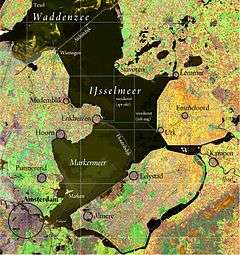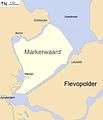Markerwaard

The Markerwaard is the name of a polder in the IJsselmeer that was never built. The construction of Markerwaard would have resulted in the near-total reclamation of the Markermeer.
Cornelis Lely's plan projected a polder in the south-west of the Zuiderzee, originally named Hoornsche Polder, referring to Hoorn, then simply "Southwest Polder".[1] Later the name was changed to Markerwaard Polder, after the island of Marken. However, reclamation of three other polders took place first, and preparations for the Markerwaard were being made while draining of the northeast and southeast polders (today's Flevoland) were underway.
In 1941 work for this project started; about 2 km of a dike north of Marken was built. It would have had an area of nearly 600 km2. But the German occupation stopped the project. Later, it was decided that the Flevopolder should have priority. In 1957, the island of Marken was connected to mainland Holland. In 1976 the dam Houtribdijk connecting Enkhuizen and Lelystad was completed, a necessary step in the construction of Markerwaard, the dikes for the bordering lakes were still to be completed. However the entire project became mired in political and environmental controversy. In the late 1970s, the project was revised down leaving wide bordering lakes between the polder and North Holland. Marken would remain a peninsula, unlike on the original project. At this stage, the Markerwaard would have had an area of 410 km2.
The debate on a final decision regarding Markerwaard took over twenty years. The questions concerned the need, on one side, for more agricultural areas, new residential subdivisions, and a new airport (to relieve pressure on Schiphol). On the other side of the debate were primarily ecological issues, with the argument that the value of the lake as a recreation area was considered by some to be stronger than the potential benefits of the polder. Additionally, it was argued that, in case of drought, the lake would be very useful for the production of drinking water, and that in heavy weather, the lake serves as a buffer zone.
Finally, in 2003, it was decided not to build this polder.[2] However discussions never completely closed.[3]
In 2012, plans emerged to create the Marker Wadden,[4] a group of islands designed to establish nature reserves in the north of the Markermeer. Contrary to the Markerwaard, no human occupation is planned. The creation process is planned to start in early 2016.[5]
-

An early project of 1891 by Lely, with no bordering lakes, the polder is called the Hoornsche Polder.
-

The Zuiderzee Works as planned in 1924 on Lely's map, the polder is called ZW Polder.
-

The Markerwaard as planned in 1965[1]
-

The Markerwaard as planned in 1981[2]
- ^ Michelin n°6 _1972
- ^ http://www.flevolandsgeheugen.nl/385/nl/de-markerwaard
References
- ↑ Ir. J.F.R. van de Wall (1952): 'De groei van het ontwerp voor de Oosterpolder', Ts. v.h. Kon. Ned. Aardr. Gen., 69:3, p.17.
- ↑ In de Nota Ruimte Ruimte voor ontwikkeling, Deel 4 Definitieve versie, Hoofdstuk 4 Gebieden en thema's, Paragraaf 6 IJsselmeergebied, Sub-paragraaf 4 Specifieke beleidskeuzen, Kop 3 Buitendijkse ontwikkelingen staat op pag. 156: "De ruimtelijke reservering voor een Markerwaard vervalt." PDF
- ↑ Vereniging Vrienden van de Markerwaard (VVM); Studiemiddag Lelystad 2005 en Plan Markermeer Plus 2008 . Also see Reformatorisch Dagblad.
- ↑ Intentieverklaring Marker Wadden, Rijkswaterstaat, Dutch government bulletin, april 2013
- ↑ Boskalis wins Marker Wadden Island contract, Dredging News Online, 15 September 2015